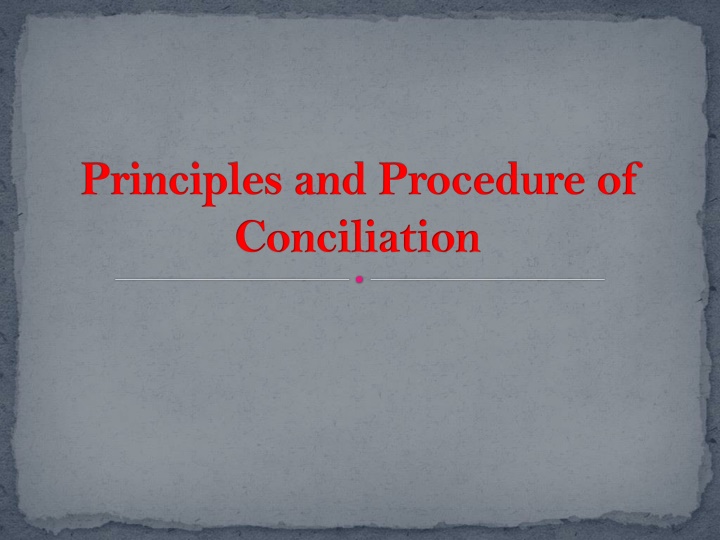
Understanding the Principles and Procedure of Conciliation
"Explore the principles and procedure of conciliation, a non-binding approach where a neutral third party assists disputing parties to reach a mutual resolution. Learn about the role of conciliators, key principles, and the process involved."
Download Presentation

Please find below an Image/Link to download the presentation.
The content on the website is provided AS IS for your information and personal use only. It may not be sold, licensed, or shared on other websites without obtaining consent from the author. If you encounter any issues during the download, it is possible that the publisher has removed the file from their server.
You are allowed to download the files provided on this website for personal or commercial use, subject to the condition that they are used lawfully. All files are the property of their respective owners.
The content on the website is provided AS IS for your information and personal use only. It may not be sold, licensed, or shared on other websites without obtaining consent from the author.
E N D
Presentation Transcript
Principles and Procedure of Conciliation
Introduction Conciliation is non binding procedures in which an impartial third party helps the parties to a dispute in reaching a mutually agreed settlement of the dispute. He/ she is being called conciliator. According to the England; Conciliation is a process of persuading parties to reach an agreement. Halsbury Laws of
In the procedure of conciliator who is often a government official gives its report recommendations which is made public. In conciliation by discussion between the parties are kept participation of a conciliator. Section 61 of the Conciliation Act of 1996 provides for the Application and Scope of Conciliation. the conciliation ,the in the form of going through the Arbitration and
Section 61 points out that the process of conciliation extends, in the first place, to disputes, whether contractual or not. But the disputes must arise out of the legal relationship. It means that the dispute must be such as to give one party the right to sue and to the other party the liability to be sued. The process of conciliation extends, in the second place, to all proceedings relating to it.
Section 63 Number And Qualification Of Conciliators There should one conciliator. But the parties may by their agreement provide for two or three conciliators. Where the number of conciliator is more than one ,they should as general rule act jointly.
Section 64 Appointment of conciliators After invitation to the conciliation is accepted by the other party, the parties have to agree on the composition of the conciliation tribunal. In the absence of any agreement to the contrary ,there shall be only one conciliator. If sole conciliator can not be appointed then each party appoint one conciliator & third must be appointed by unanimously by both the parties. While making appointment they can also take help of institution.
Principles of Procedure Confidentiality Disclosure of the information Fairness and justice PRINCIPLES & PROCEDURE Co- Independence & impartiality operation of the parties with Conciliator
Procedure Of Conciliation Commencement of the conciliation proceedings Submission of Statement to Conciliator Conduct of Conciliation Proceedings Administrative assistance
